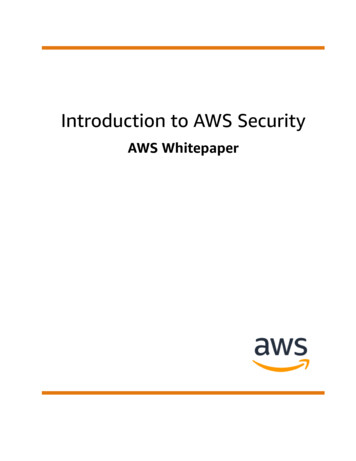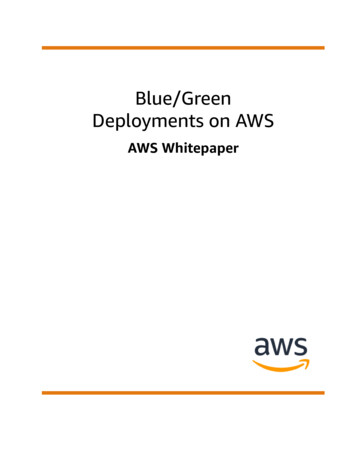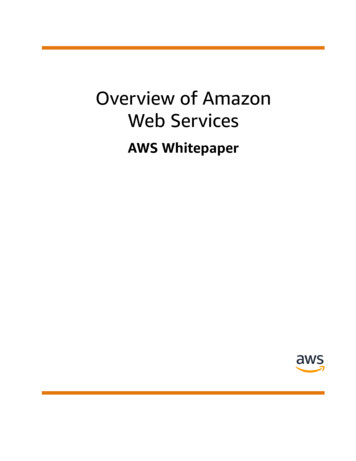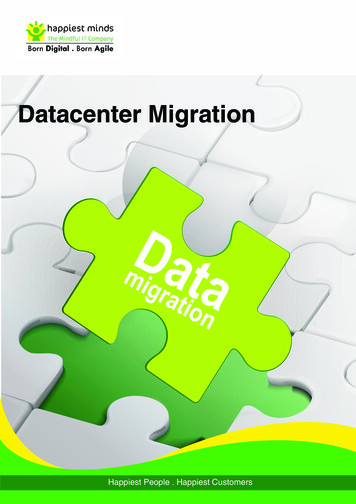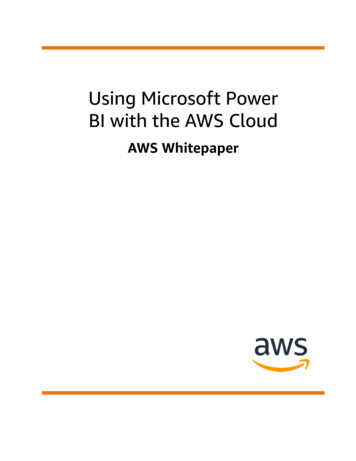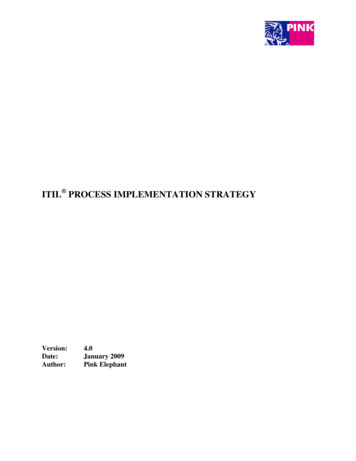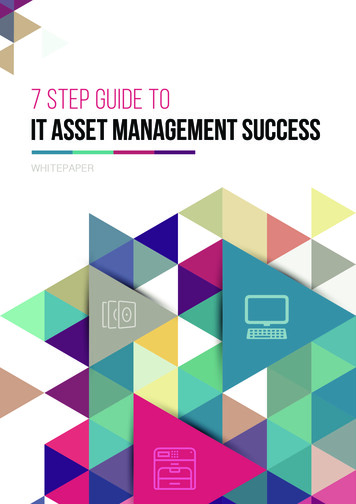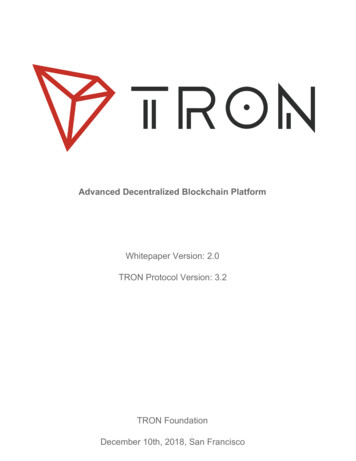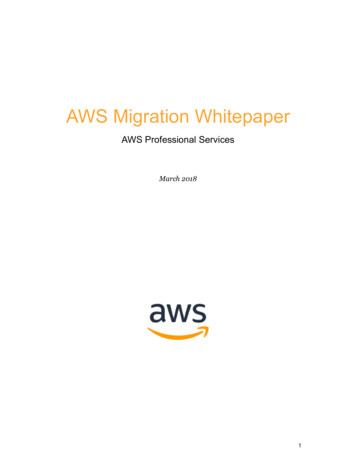
Transcription
AWS Migration WhitepaperAWS Professional ServicesMarch 20181
2018, Amazon Web Services, Inc. or its affiliates. All rights reserved.NoticesThis document is provided for informational purposes only. It represents AWS’scurrent product offerings and practices as of the date of issue of this document,which are subject to change without notice. Customers are responsible formaking their own independent assessment of the information in this documentand any use of AWS’s products or services, each of which is provided “as is”without warranty of any kind, whether express or implied. This document doesnot create any warranties, representations, contractual commitments,conditions or assurances from AWS, its affiliates, suppliers or licensors. Theresponsibilities and liabilities of AWS to its customers are controlled by AWSagreements, and this document is not part of, nor does it modify, any agreementbetween AWS and its customers.2
ContentsIntroduction1Using the AWS Cloud Adoption Framework (AWS CAF) to Assess MigrationReadiness2Impact of Culture on Cloud Migration4Business Drivers5Migration Strategies7“The 6 R’s”: 6 Application Migration Strategies7Which Migration Strategy is Right for Me?9Building a Business Case for Migration12People and Organization15Organizing Your Company’s Cloud Teams15Creating a Cloud Center of Excellence15Migration Readiness and Planning17Assessing Migration Readiness17Application Discovery19Application Discovery Tools20Application Portfolio Analysis21Migration Planning22Technical Planning23The Virtual Private Cloud Environment24Migrating29First Migrations – Build Experience29Migration Execution30Application Migration Process30Team Models32Conclusion34Contributors353
Resources35Additional Information35FAQ36Glossary374
AbstractAdopting Amazon Web Services presents many benefits, such as increasedbusiness agility, flexibility, and reduced costs. As an enterprise’s cloud journeyevolves from building and running cloud native applications on AWS, tomapping out the migration of an entire enterprise IT estate, certain challengessurface. Migrating at scale to AWS calls for a level of business transformation inorder to fully realize the numerous benefits of operating in a cloud environment,including changes to tools, processes and skillsets.The AWS approach is a culmination of our experiences in helping largecompanies migrate to the cloud. From these experiences, we have developed aset of methods and best practices to enable a successful move to AWS. Here wediscuss the importance of driving organizational change and leadership, how toestablish foundational readiness and plan for migrating at scale, and ouriterative approach to migration execution.Migrating to AWS requires an iterative approach, which begins with buildingand evolving your business case as you and your team learn and uncover moredata over time, through activities like application portfolio discovery andportfolio analysis. There are the common migration strategies which will informyour business plan, and a recommended approach to organizing and evolvingyour cloud teams as confidence and capability increases. You will stand up aCloud Center of Excellence (CCoE) to lead and drive change, evangelize yourcloud migration initiative, establish cloud governance guardrails, and enableand prepare your organization to provide and consume new services. Ourapproach walks you through what it means to be ready to migrate at scale, andhow to establish a solid foundation to save time and prevent roadblocks downthe road. We will cover our approach to migration execution, continuing on withbuilding momentum and acceleration through a method of learn-and-iterate.5
Amazon Web Services – AWS Migration WhitepaperIntroductionMigrating your existing applications and IT assets to the Amazon Web Services(AWS) Cloud presents an opportunity to transform the way your organizationdoes business. It can help you lower costs, become more agile, develop newskills more quickly, and deliver reliable, globally available services to yourcustomers. Our goal is to help you to implement your cloud strategysuccessfully.AWS has identified key factors to successful IT transformation through ourexperience engaging and supporting enterprise customers. We have organizedthese into a set of best practices for successful cloud migration. Customerscenarios range from migrating small, single-applications, to migrating entiredata centers with hundreds of applications. We provide an overview of the AWSmigration methodology, which is built on iterative and continuous progress. Wediscuss the principles that drive our approach, and the essential activities thatare necessary for successful enterprise migrations.Migrating to AWS is an iterative process that evolves as your organizationdevelops new skills, processes, tools, and capabilities. The initial migrationshelp build experience and momentum, that accelerate your later migrationefforts. Establishing the right foundation is key to a successful migration. Ourmigration process balances the business and technical efforts needed tocomplete a cloud migration. We identify key business drivers for migration andpresent best strategies for planning and executing a cloud migration.Once you understand why you are moving to the cloud, it is time to address howto get there. There are many challenges to completing a successful cloudmigration. We have collected common customer questions from hundreds ofcloud migration journeys and listed them here to illustrate common concerns asyou embark on your cloud migration journey. The order and prioritization willvary based on your unique circumstances, but we believe the exercise ofthinking through and prioritizing your organization’s concerns upfront isbeneficial: How do I build the right business case? How do I accurately assess my environment?Page 1
Amazon Web Services – AWS Migration Whitepaper How do I learn what I don’t know about my enterprise network topologyand application portfolio? How do I create a migration plan? How do I identify and evaluate the right partners to help me? How do I estimate the cost of a large transition like this? How long will the migration process take to complete? What tools will I need to complete the migration? How do I handle my legacy applications? How do I accelerate the migration effort to realize the business andtechnology benefits?These questions and many more will be answered throughout this paper. Wehave included support and documentation, such as the AWS Cloud MigrationPortal.1 The best practices described in this paper will help you build afoundation for a successful migration, including building a solid business plan,defining appropriate processes, and identifying best-in-class migration toolsand resources to complete the migration. Having this foundation will help youavoid the typical migration pitfalls that can lead to cost overruns and migrationdelays.The Cloud Adoption Framework (AWSCAF)AWS developed the AWS Cloud Adoption Framework (AWS CAF), which helpsorganizations understand how cloud adoption transforms the way they work.AWS CAF leverages our experiences assisting companies around the world withtheir Cloud Adoption Journey. Assessing migration readiness across keybusiness and technical areas, referred to as Perspectives, helps determine themost effective approach to an enterprise cloud migration effort. First let’soutline what we mean by perspective. AWS CAF is organized into six areas offocus, which span your entire organization. We describe these areas of focus asPerspectives: Business, People, Governance, Platform, Security, and Operations.For further reading please see the AWS CAF Whitepaper.2 AWS CAF provides amental model to establish areas of focus in determining readiness to migrateand creating a set of migration execution workstreams. As these are key areas ofPage 2
Amazon Web Services – AWS Migration Whitepaperthe business impacted by cloud adoption, it’s important that we create amigration plan which considers and incorporates the necessary requirementsacross each area.Figure 1: AWS Cloud Adoption Framework People and Technology PerspectivesThe following table presents a description of each Perspective and the commonroles involved.Table 1: AWS CAF perspectivesPerspectiveDescription and Common Roles InvolvedBusinessBusiness support capabilities to optimize business value with cloud adoption.Common Roles: Business Managers; Finance Managers; Budget Owners; StrategyStakeholdersPeoplePeople development, training, communications, and change management.Common Roles: Human Resources; Staffing; People Managers.GovernanceManaging and measuring resulting business outcomes.Common Roles: CIO; Program Managers; Project Managers; Enterprise Architects;Business Analysts; Portfolio Managers.PlatformDevelop, maintain, and optimize cloud platform solutions and services.Common Roles: CTO; IT Managers; Solution Architects.SecurityDesigns and allows that the workloads deployed or developed in the cloud align to theorganization’s security control, resiliency, and compliance requirements.Common Roles: CISO; IT Security Managers; IT Security Analysts; Head of Audit andCompliance.OperationsAllows system health and reliability through the move to the cloud, and delivers anagile cloud computing operation.Common Roles: IT Operations Managers; IT Support Managers.Page 3
Amazon Web Services – AWS Migration WhitepaperMotivating ChangeCultural issues are at the root of many failed business transformations,yet most organizations do not assign explicit responsibility for culture.– Gartner, 2016Culture is critical to cloud migration. Cloud adoption can fail to reach maximumpotential if companies do not consider the impact to culture, people, andprocesses, in addition to the technology. On-premises infrastructure has beenhistorically managed by people, and even with advancements in servervirtualization most companies have not been able to implement the levels ofautomation that the cloud can provide. The AWS platform provides customersinstant access to infrastructure and applications services through a pay-as-yougo pricing model. You can automate the provisioning of AWS resources usingAWS service APIs. As a result, roles and responsibilities within yourorganization will change as application teams take more control of theirinfrastructure and application services.The impact of culture on cloud, and cloud on culture, does not need to be adaunting or arduous proposition. Be aware and intentional about the culturalchanges you are looking to drive and manage the people-side of change.Measure and track the cultural change, just as you would the technology change.We recommend implementing an organizational change management (OCM)framework to help drive the desired changes throughout your organization.Page 4
Amazon Web Services – AWS Migration WhitepaperTable 2: Organizational change management to accelerate yourcloud transformationhe AWS OCM Framework guides you through mobilizing your people, aligningleadership, envisioning the future state of operating in the cloud, engaging yourorganization beyond the IT environment, enabling capacity, and making all ofthose changes stick for the long term. You can find additional information onthis topic in the Resources section of this paper.Business DriversThe number one reason customers choose to move to the cloud is for the agilitythey gain. The AWS Cloud provides more than 90 services including everythingfrom compute, storage, and databases, to continuous integration, data analytics,and artificial intelligence. You are able to move from idea to implementation inminutes rather than the months it can take to provision services on-premises.In addition to agility, other common reasons customers migrate to the cloudinclude increased productivity, data center consolidation or rationalization, andpreparing for an acquisition, divestiture, or reduction in infrastructure sprawl.Some companies want to completely re-imagine their business as part of alarger digital transformation program. And, of course, organizations are alwayslooking for ways to reduce costs.Common drivers that apply when migrating to the cloud are:Page 5
Amazon Web Services – AWS Migration WhitepaperOperational Costs – Operational costs are the costs of running yourinfrastructure. They include the unit price of infrastructure, matching supplyand demand, investment risk for new applications, markets, and ventures,employing an elastic cost base, and building transparency into the IT operatingmodel.Workforce Productivity – Workforce productivity is how efficiently you areable to get your services to market. You can quickly provision AWS services,which increases your productivity by letting you focus on the things that makeyour business different; rather than spending time on the things that don’t, likemanaging data centers. With over 90 services at your disposal, you eliminatethe need to build and maintain these independently. We see workforceproductivity improvements of 30%-50% following a large migration.Cost Avoidance – Cost avoidance is setting up an environment that does notcreate unnecessary costs. Eliminating the need for hardware refresh andmaintenance programs is a key contributor to cost avoidance. Customers tell usthey are not interested in the cost and effort required to execute a big refreshcycle or data center renewal and are accelerating their move to the cloud as aresult.Operational Resilience – Operational resilience is reducing yourorganization’s risk profile and the cost of risk mitigation. With 16 Regionscomprising 42 Availability Zones (AZs) as of June 2017, With AWS, you candeploy your applications in multiple regions around the world, which improvesyour uptime and reduces your risk-related costs. After migrating to AWS, ourcustomers have seen improvements in application performance, better security,and reduction in high-severity incidents. For
data over time, through activities like application portfolio discovery and portfolio analysis. There are the common migration strategies which will inform your business plan, and a recommended approach to organizing and evolving your cloud teams as confidence and capability increases. You will stand up a
